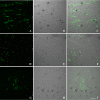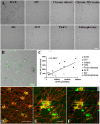In vivo CHI3L1 (YKL-40) expression in astrocytes in acute and chronic neurological diseases
- PMID: 20540736
- PMCID: PMC2892443
- DOI: 10.1186/1742-2094-7-34
In vivo CHI3L1 (YKL-40) expression in astrocytes in acute and chronic neurological diseases
Abstract
Background: CHI3L1 (YKL-40) is up-regulated in a variety of inflammatory conditions and cancers. We have previously reported elevated CHI3L1 concentration in the cerebrospinal fluid (CSF) of human and non-human primates with lentiviral encephalitis and using immunohistochemistry showed that CHI3L1 was associated with astrocytes.
Methods: In the current study CHI3L1 transcription and expression were evaluated in a variety of acute and chronic human neurological diseases.
Results: ELISA revealed significant elevation of CHI3L1 in the CSF of multiple sclerosis (MS) patients as well as mild elevation with aging. In situ hybridization (ISH) showed CHI3L1 transcription mostly associated with reactive astrocytes, that was more pronounced in inflammatory conditions like lentiviral encephalitis and MS. Comparison of CHI3L1 expression in different stages of brain infarction showed that YKL40 was abundantly expressed in astrocytes during acute phases and diminished to low levels in chronic infarcts.
Conclusions: Taken together, these findings demonstrate that CHI3L1 is induced in astrocytes in a variety of neurological diseases but that it is most abundantly associated with astrocytes in regions of inflammatory cells.
Figures





References
-
- Johansen JS. Studies on serum YKL-40 as a biomarker in diseases with inflammation, tissue remodelling, fibroses and cancer. Dan Med Bull. 2006;53:172–209. - PubMed
-
- Jensen BV, Johansen JS, Price PA. High levels of serum HER-2/neu and YKL-40 independently reflect aggressiveness of metastatic breast cancer. Clin Cancer Res. 2003;9:4423–4434. - PubMed
-
- Hormigo A, Gu B, Karimi S, Riedel E, Panageas KS, Edgar MA, Tanwar MK, Rao JS, Fleisher M, DeAngelis LM, Holland EC. YKL-40 and matrix metalloproteinase-9 as potential serum biomarkers for patients with high-grade gliomas. Clin Cancer Res. 2006;12:5698–5704. doi: 10.1158/1078-0432.CCR-06-0181. - DOI - PubMed
Publication types
MeSH terms
Substances
Grants and funding
LinkOut - more resources
Full Text Sources
Other Literature Sources
Medical

